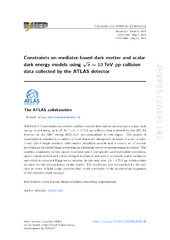Constraints on mediator-based dark matter and scalar dark energy models using √s = 13 TeV pp collision data collected by the ATLAS detector
Aaboud, Morad; Aad, Georges; Abbott, Brad; Abbott, Dale C.; Abdinov, Ovsat Bahram oglu; Abhayasinghe, Deshan Kavishka; Abidi, Syed Haider; AbouZeid, Hass; Abraham, Nadine L.; Abramowicz, Halina; Buanes, Trygve; Djuvsland, Julia Isabell; Eigen, Gerald; Fomin, Nikolai; Lipniacka, Anna; Martin dit Latour, Bertrand; Mæland, Steffen; Stugu, Bjarne; Yang, Zongchang; Bugge, Magnar Kopangen; Cameron, David Gordon; Catmore, James Richard; Feigl, Simon; Garonne, Vincent; Gramstad, Eirik; Hellesund, Simen; Morisbak, Vanja; Oppen, Henrik; Ould-Saada, Farid; Pedersen, Maiken; Read, Alexander Lincoln; Røhne, Ole Myren; Sandaker, Heidi; Serfon, Cédric; Vadla, Knut Oddvar Høie; Abreu, Henso; Abulaiti, Yiming; Acharya, Bobby S.; Adachi, Shunsuke; Adam, Lennart; Adam-Bourdarios, Claire; Adamczyk, Leszek; Adamek, Lukas; Adelman, Jareed; Adersberger, Michael; Adigüzel, Aytül; Adye, Tim; Affolder, Anthony Allen; Afik, Yoav; Agapopoulou, Christina; ATLAS, Collaboration
Peer reviewed, Journal article
Published version

Åpne
Permanent lenke
https://hdl.handle.net/1956/23814Utgivelsesdato
2019Metadata
Vis full innførselSamlinger
Originalversjon
https://doi.org/10.1007/jhep05(2019)142Sammendrag
Constraints on selected mediator-based dark matter models and a scalar dark energy model using up to 37 fb−1s√ = 13 TeV pp collision data collected by the ATLAS detector at the LHC during 2015-2016 are summarised in this paper. The results of experimental searches in a variety of final states are interpreted in terms of a set of spin-1 and spin-0 single-mediator dark matter simplified models and a second set of models involving an extended Higgs sector plus an additional vector or pseudo-scalar mediator. The searches considered in this paper constrain spin-1 leptophobic and leptophilic mediators, spin-0 colour-neutral and colour-charged mediators and vector or pseudo-scalar mediators embedded in extended Higgs sector models. In this case, also s√ = 8 TeV pp collision data are used for the interpretation of the results. The results are also interpreted for the first time in terms of light scalar particles that could contribute to the accelerating expansion of the universe (dark energy).
